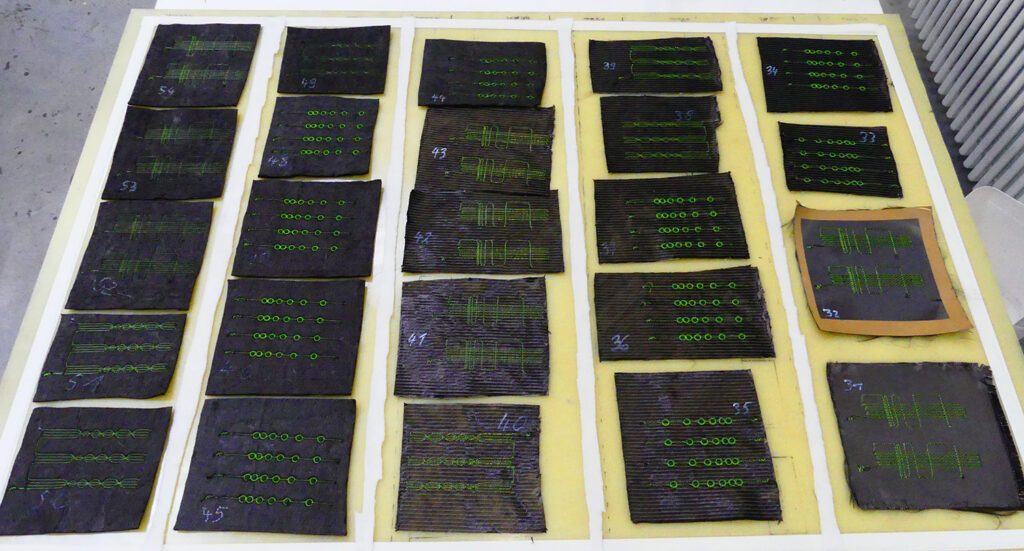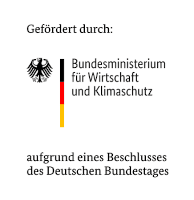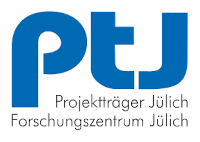For the reinforcement of fiber-reinforced plastics, carbon fibers currently have density related the highest mechanical property potential. The electrical conductivity of carbon fibers is also already being used, for example in selected applications for resistance heating. As part of an R&D project, STFI has now investigated whether the electrical conductivity of carbon fibers can be used in textile structures and laminates for data storage without the use of foreign materials.
- embroidery base (fabric, biaxial scrim, rCF non-woven fabric) made of carbon and glass fibers,
- size, shape and spacing of the data structures, e.g. ring-shaped with Ø 10mm,
- Roving thickness (3K – 12K) and multiple layers.
The data carrier structures were examined dry and as laminates. For the laminates, the influence of the RFID embedding depth, i. H. the dependency on the sample thickness. A test bench was developed for the investigations, which enables surfaces to be lined up.

(0mm, 4mm, 7mm, 12mm, 22mm, 42mm)

Results
After testing the test bench, preliminary tests and an optimization phase, the information density of the binary/dual code was increased from 4 to 16 bits. This enables storage of 65,472 information/measurement values. To encode EPC data, the CF data carrier could easily be ex-panded to 96-bit, 128-bit or 240-bit EPC tags.
Conclusion and outlook
Inductive measurement technology has proven to be superior to capacitive ones in terms of measurement mimicry, detectability and susceptibility to interference. Carbon fiber-based data carrier structures can be integrated into the manufacturing process of laminates and read out. The readout of information depends on the depth of the CF data carrier in the laminate, the thickness of the rovings and the geometry of the microstructure. A frequency-adapted inductance is required for reading out in intermediate layers of multi-layer carbon fiber structures.
The project created the basis for replacing environmentally harmful RFID systems in the carbon fiber-based composite industry with structures free of foreign materials in the medium term. The coding, which is invisible from the outside, offers potential for protection against product piracy and can be seen as a new and sustainable principle of material-intrinsic data storage.
Motivation
RFID technology for the automatic and contactless identification and localization of objects is present both for production and transport logistics as well as in everyday life. The small radio chips contain e.g. acrylates, silicon, copper, aluminium, silver, epoxy resins, nickel and PET. As a rule, RFIDs only have a minimal mass share in the product. Currently, recycling concepts are preferably tailored to the material of the product. Thus, the valuable components in the RFID are lost as material resources and at the same time pose a threat to the environment, health and waste management. In addition, the proportion of plastics in RFID systems exacerbates the microplastic contamination of the world‘s oceans. The Federal Environment Agency (UBA) already forecast in 2007 a rapid increase in the entry of im-purities from RFID into the environment to around 800 t per year by 2020. To date, these problems have neither been solved nor tackled.
STFI would like to thank the Federal Ministry of Economics and Climate Protection for funding the project (Reg. No. 49VF190026) within the funding program
‘R&D-promotion of non-profit external industrial research institutions – innovation competence (INNO-KOM) – module preliminary research’.
Contact:
STFI – Sächsisches Textilforschungsinstitut e.V., Chemnitz
www.stfi.de







![BMBF_CMYK_Gef_M [Konvertiert]](https://composites-united.com/wp-content/uploads/2022/03/BMBF_gefoerdert_en_rgb.jpg)









